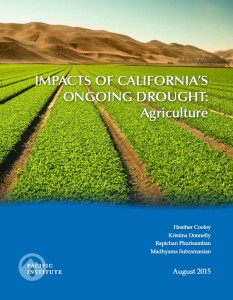Impacts of California’s Ongoing Drought: Agriculture

Impacts of California’s Ongoing Drought: Agriculture
In 2015, California was in the midst of the most severe drought in nearly 120 years of instrumental record, with far-reaching effects in the state. This report examines the impacts of the drought on California’s agricultural sector through 2014. It finds that while harvested acreage in California declined during the drought, agricultural revenue remained high, due to a range of response strategies. Some of the strategies will build resilience to climate change, while others — principally the severe overdrafting of groundwater supplies — will have lasting and damaging consequences for local communities, ecosystems, and future generations. The impacts of the drought on California agriculture, and responses to it, provide policymakers, farmers, and agriculture officials insight into how the state can maintain a healthy agricultural sector in a future likely to see less water, more extreme weather, and greater uncertainty.
Key findings include: The overall resilience of the state’s agricultural sector conceals some important negative local impacts. For example, crop production was buffered through extensive and unsustainable overdraft of groundwater. Continued groundwater overdraft, while reducing the economic impacts of the drought for the agricultural sector now, shifted the burden to others, including current and future generations forced to dig deeper wells, find alternative drinking water sources, and repair infrastructure damaged by subsidence. The study concludes that a series of responses have protected California’s economy and job levels from drought-induced declines. Some of these responses will build resilience while others will have lasting and damaging consequences to local communities, ecosystems, and future generations. The protracted drought provides policymakers, farmers, and agriculture officials a unique and urgent opportunity to plan for and implement more sustainable water use policies and practices to support a vibrant and sustainable agriculture sector in California.
Overview
Key Findings
Resources
In this Series

